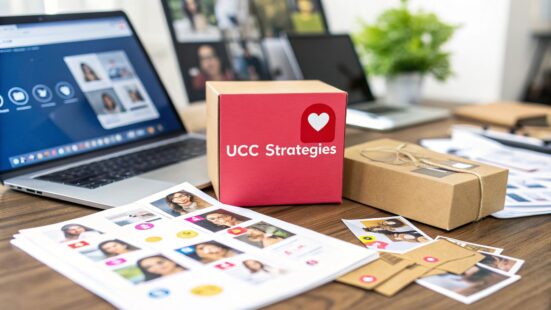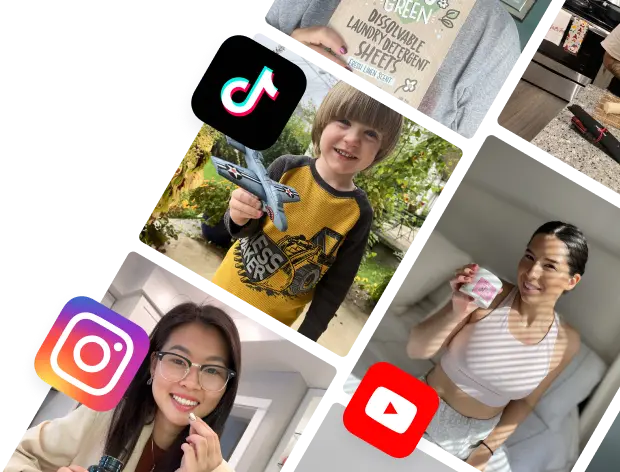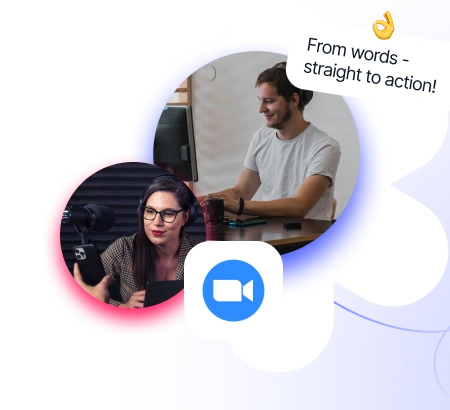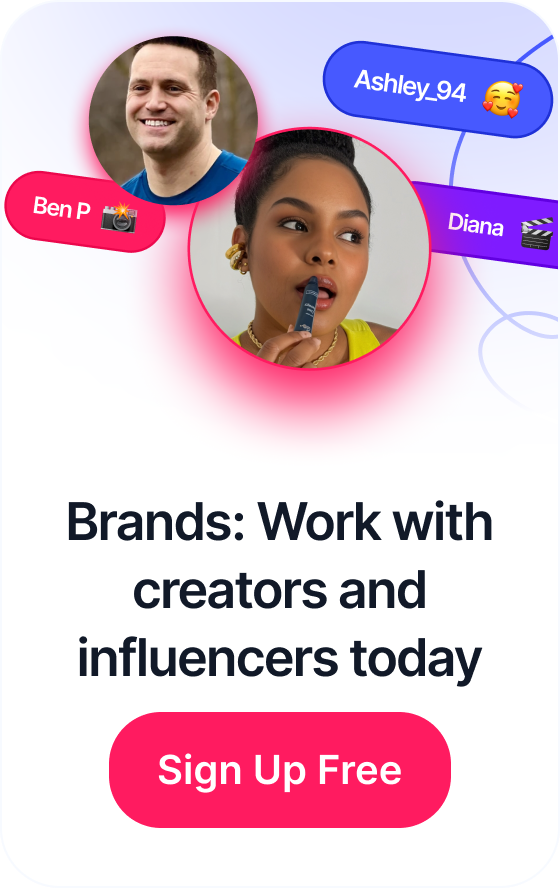 Mastering Social Media Campaign Reporting
Mastering Social Media Campaign Reporting
In a market saturated with polished brand messaging, authentic voices cut through the noise. User-generated content (UGC) is no longer a "nice-to-have" marketing tactic; it's a foundational element for building trust, community, and sustainable growth. Consumers trust peer recommendations far more than brand advertisements, making UGC a powerful tool for driving conversions and fostering genuine brand loyalty. For direct-to-consumer and e-commerce brands, a well-defined UGC plan is the key to creating a self-sustaining marketing engine fueled by your most passionate customers.
This article moves beyond the abstract to provide a tactical playbook. We will break down nine specific user generated content strategies that you can implement immediately, from running dynamic hashtag campaigns to building dedicated brand community platforms. Each strategy is detailed with actionable steps, real-world examples, and practical tips to maximize impact. Whether you're looking to boost engagement, gather authentic social proof, or co-create products with your audience, these methods offer a clear path forward. While the core principles apply broadly, seeing how different organizations build community can offer unique insights; for example, to truly understand the comprehensive landscape of social media's role in building community and engagement, consider a complete guide to social media for churches for a different perspective on similar goals. Let's dive into the strategies that will transform your customers from passive buyers into active brand advocates.
Table of Contents
1. Hashtag Challenges and Campaigns
Hashtag challenges are a cornerstone of modern user generated content strategies, transforming passive audiences into active brand participants. This approach involves creating a unique, branded hashtag and pairing it with a simple, engaging prompt or challenge. The goal is to encourage users to create and share content related to the theme, effectively turning customers into a powerful, decentralized marketing force that amplifies brand reach and engagement.

This strategy excels at generating massive volumes of authentic content quickly. For instance, Starbucks' annual #RedCupContest invites customers to share creative photos of their holiday-themed cups, flooding social feeds with festive, brand-centric imagery. Similarly, Coca-Cola's #ShareACoke campaign encouraged people to find bottles with their names and share photos, creating a powerful sense of personal connection and shareability.
How to Implement a Hashtag Challenge
To launch a successful campaign, focus on clarity and motivation. A low barrier to entry is critical; the easier it is for someone to participate, the more likely they are to join in.
- Define a Simple, Creative Prompt: Your challenge should be easy to understand and execute. Guess’s #InMyDenim challenge simply asked users to showcase their style transformation, a concept perfectly suited for TikTok's short-form video format.
- Offer Compelling Incentives: Motivate participation by offering prizes, discounts, or the chance to be featured on your brand's official channels. This recognition validates participants' efforts and encourages others to contribute.
- Seed the Campaign with Influencers: Kickstart momentum by collaborating with influencers or brand advocates. Their initial posts provide social proof and a template for other users to follow, helping the challenge gain early traction.
- Promote and Engage Actively: Announce your campaign across all your marketing channels, not just social media. Actively monitor the hashtag, then like, comment on, and share submissions to foster a sense of community and keep the energy high.
2. Customer Review and Testimonial Programs
Customer review and testimonial programs are foundational user generated content strategies that systemize the collection and amplification of customer feedback. This approach transforms satisfied buyers into credible brand advocates by actively encouraging them to share their experiences. By showcasing these authentic voices across product pages, social media, and marketing campaigns, brands build powerful social proof that significantly influences purchasing decisions and fosters trust with prospective customers.

This strategy is highly effective because modern consumers trust peer recommendations far more than traditional advertising. For example, Amazon’s comprehensive review system is central to its e-commerce dominance, while Airbnb’s two-way review model created the necessary trust for its platform to thrive. Similarly, beauty brand Glossier masterfully integrates customer photos and quotes directly onto its product pages, blurring the line between marketing and genuine user endorsement.
How to Implement a Review and Testimonial Program
A successful program makes it easy for customers to share feedback and makes that feedback visible where it matters most. Simplicity and strategic timing are key to maximizing participation and impact.
- Time Your Requests Strategically: Send review requests shortly after a positive customer interaction, such as product delivery or a successful customer service experience. This timing captures enthusiasm when it's at its peak.
- Simplify the Submission Process: Reduce friction by sending direct links to a simple review form. The fewer steps a customer has to take, the more likely they are to leave feedback.
- Encourage Visuals: Prompt customers to include photos or videos with their reviews. Visual testimonials are more engaging and provide powerful, authentic context for potential buyers.
- Showcase Reviews Prominently: Feature your best reviews and testimonials on your homepage, product pages, and in your social media and email marketing. This visibility ensures the social proof is seen by new audiences.
3. Photo and Video Contests
Photo and video contests are a classic and highly effective component of many user generated content strategies, incentivizing audiences to create high-quality visual assets for your brand. This method involves inviting users to submit original photos or videos based on a specific theme related to your products or brand ethos. In return for their creativity, participants compete for prizes, recognition, or features, generating a library of authentic and compelling marketing materials.

This strategy is powerful because it gamifies content creation and taps into the competitive spirit of your community. GoPro has mastered this with its continuous challenges, encouraging users to submit their best action shots captured with GoPro cameras, which perfectly demonstrates the product's capabilities. Similarly, outdoor retailer REI’s #OptOutside photo contests build a strong community by celebrating shared values of adventure and nature, flooding social media with on-brand imagery.
How to Implement a Photo or Video Contest
A successful contest requires clear rules, appealing rewards, and transparent legal frameworks. The goal is to maximize participation while ensuring the content you receive is on-brand and usable.
- Set Clear and Specific Guidelines: Define the theme, submission format, and quality requirements to guide participants and ensure you receive brand-aligned content. Vague rules can lead to off-topic or low-quality entries.
- Offer Attractive, Relevant Prizes: Your prize should motivate your target audience. This could be a significant cash prize, a large bundle of your products, or a unique experience they can't get elsewhere.
- Secure Legal Rights for Content Use: Your terms and conditions must clearly state how you plan to use the submitted photos and videos. This protects both your brand and the creators, ensuring you have the rights to repurpose the content in future marketing.
- Promote Heavily Across Channels: Announce your contest on all platforms, including social media, email newsletters, and your website. Use a dedicated hashtag to track submissions and amplify visibility.
4. Brand Community Platforms and Forums
Brand community platforms are dedicated online spaces where customers can connect, share experiences, and generate content related to your brand. This is one of the most powerful user generated content strategies for building long-term loyalty, as it transforms transactional relationships into deeply engaged communities. These forums or platforms create a continuous feedback loop and an evergreen source of authentic content, from product tips to success stories.

This strategy excels at fostering brand advocacy and reducing customer support costs. For example, the Sephora Beauty Insider Community allows members to share makeup tips, ask for product recommendations, and post photos of their looks, all while building a vibrant ecosystem around beauty. Similarly, LEGO Ideas enables fans to submit and vote on new product concepts, directly involving the community in product development and generating immense excitement.
How to Implement a Brand Community Platform
Building a successful community requires a clear purpose and active nurturing. It's a long-term investment that pays dividends in brand loyalty and authentic content.
- Define a Clear Community Purpose: Start by defining what value your community will offer members. Is it a place for support, inspiration, or collaboration? This purpose will guide your content and moderation strategy.
- Seed Initial Content and Invite Advocates: Launch your platform by inviting your most passionate customers and seeding it with valuable discussion starters, tutorials, or Q&As. This initial activity encourages new members to participate.
- Recognize and Reward Top Contributors: Acknowledge your most active members with badges, exclusive access, or features in your marketing. This recognition motivates continued engagement and sets a positive example for the community.
- Integrate Community Insights: Actively monitor discussions to gather feedback for product development and marketing. This demonstrates that you value your community's input and helps you create better products. Learn more about how to increase social media engagement by fostering these connections.
5. Influencer and Ambassador Partnerships
Influencer and ambassador partnerships are strategic user generated content strategies that leverage the credibility of established content creators. This approach involves collaborating with individuals who have a dedicated following, allowing your brand to tap into their authentic voice and audience trust. By working with influencers, brands can generate high-quality, relatable content that resonates more deeply than traditional advertising.
This strategy is highly effective because it places your product in a natural, trusted context. For example, Daniel Wellington famously built its brand by partnering with thousands of micro-influencers, flooding Instagram with stylish, aspirational photos. Similarly, fitness brand Gymshark fostered a tight-knit community by building long-term relationships with fitness athletes, turning them into passionate brand ambassadors who create a continuous stream of authentic workout and lifestyle content.
How to Implement Influencer and Ambassador Partnerships
A successful partnership relies on authentic alignment and clear communication. The goal is to build genuine relationships that benefit both the brand and the creator, leading to more compelling UGC.
- Align on Values and Audience: Choose partners whose personal brand, values, and audience demographics align with yours. Focus on engagement rates and audience trust over raw follower count to ensure you’re reaching an interested community.
- Grant Creative Freedom with Clear Guidelines: Provide influencers with creative autonomy to maintain their authentic voice, which is what their audience values. However, supply clear brand guidelines, campaign goals, and key messaging to ensure consistency.
- Build Long-Term Relationships: Prioritize long-term partnerships over one-off sponsored posts. This builds deeper brand loyalty and allows ambassadors to integrate your product more naturally into their content over time.
- Measure and Track Performance: Use unique discount codes, affiliate links, and UTM parameters to track the ROI of your partnerships. This data is crucial for identifying your most effective collaborators and refining your overall influencer strategy.
6. Social Media Takeovers
Social media takeovers are a dynamic form of user generated content strategies where a brand temporarily hands over control of its accounts to an external voice. This could be an influencer, a loyal customer, a partner, or even an employee, who then creates content from their unique perspective. This strategy injects authenticity and fresh energy into a brand's feed, offering followers a behind-the-scenes look or a completely different viewpoint.
This approach excels at building trust and community by humanizing a brand. For instance, National Geographic often lets its photographers take over its Instagram, sharing breathtaking images and personal stories from their expeditions. Similarly, Airbnb frequently features hosts who showcase their unique properties and local travel tips, providing authentic content that feels more like a recommendation from a friend than a corporate advertisement.
How to Implement a Social Media Takeover
A successful takeover requires careful planning and clear communication to align the guest's content with your brand’s voice and goals. Trust is key, but so is preparation.
- Vet and Brief Participants Thoroughly: Choose creators who align with your brand values. Provide them with clear guidelines, goals, and key messaging points, but allow for creative freedom.
- Create a Compelling Storyline: Plan a theme or narrative for the takeover period. This could be a "day in the life," a special event, a Q&A session, or a project showcase to give the content a clear focus.
- Promote the Takeover in Advance: Build anticipation by announcing the takeover across your channels. Introduce your guest host and let your audience know what to expect and when to tune in.
- Encourage Interactive Elements: The best takeovers involve direct audience engagement. Encourage the host to run live Q&As, polls, and quizzes to create a two-way conversation and make the experience more memorable.
7. Branded Content Creation Tools and Templates
Providing branded content creation tools is an advanced user generated content strategy that empowers your audience by giving them the assets to create on-brand content. This approach involves offering digital tools like custom filters, stickers, and video templates, which lowers the barrier to creation and ensures that the resulting UGC aligns with your brand's aesthetic. It turns content creation into a guided, yet creative, experience for the user.
This strategy brilliantly merges user creativity with brand consistency. For example, Spotify’s annual "Wrapped" campaign provides users with vibrant, shareable graphics summarizing their listening habits, turning personal data into a viral marketing event. Similarly, Nike frequently releases custom Instagram filters and AR effects for new product launches, allowing fans to virtually "try on" new gear and share the experience with their followers.
How to Implement Branded Creation Tools
Success with this strategy hinges on making your tools accessible, fun, and easy to use. The goal is to enhance the user’s content, not to restrict it with overly rigid branding.
- Develop Mobile-First Assets: Design filters, stickers, and templates primarily for mobile use, as this is where most social content is created and shared. Ensure they are optimized for popular platforms like Instagram, TikTok, and Snapchat.
- Provide Variety and Maintain Relevance: Offer a range of templates and effects to prevent content from looking repetitive. Update your assets seasonally or for special events to keep them fresh and encourage continued use.
- Create Clear Instructions and Guidelines: While the tools should be intuitive, providing simple tutorials can increase adoption. It is also important to have clear usage permissions. Developing strong brand guidelines on joinbrands.com will ensure your assets are used correctly.
- Promote Your Tools Actively: Announce new tools and templates across all your marketing channels. Collaborate with influencers to showcase how the tools can be used creatively, providing inspiration and social proof for your wider audience.
8. Customer Spotlight and Feature Programs
Customer spotlight programs are one of the most powerful user generated content strategies for building deep, authentic connections. This approach involves regularly selecting and featuring individual customers, celebrating their stories, achievements, or unique ways they use your products. By turning customers into brand heroes, you generate highly relatable content that serves as a powerful, narrative-driven testimonial.
This strategy humanizes your brand and builds a strong sense of community. For instance, Peloton’s member spotlights celebrate incredible fitness transformations and personal triumphs, inspiring the entire user base. Similarly, Adobe’s Creative Cloud blog regularly features artists and designers, showcasing the incredible work made possible by their tools while giving creators a valuable platform. These features are more than just reviews; they are compelling stories that resonate on a personal level.
How to Implement a Customer Spotlight Program
A successful spotlight program requires a systematic approach to identifying, celebrating, and amplifying customer stories. The goal is to make the featured customer feel truly valued and to create content that inspires others.
- Develop Clear Selection Criteria: Define what makes a customer story a good fit for your brand. This could be based on exceptional product usage, a compelling personal journey, or alignment with your core brand values, like Patagonia’s features on environmental activists.
- Create a Systematic Outreach Process: Don’t wait for stories to come to you. Actively seek out potential features by monitoring social media mentions, reviews, and community forums. Create a simple submission form or outreach template to streamline the process.
- Invest in High-Quality Production: Honor your customers’ stories by investing in professional-quality content. This could mean a well-written blog post, a high-quality video interview, or professional photography to ensure their story is presented in the best possible light.
- Promote Features Across All Channels: Maximize the impact of each spotlight by sharing it across your website, email newsletters, social media, and even paid ads. Create a dedicated, searchable archive on your site so these evergreen stories continue to provide value.
9. Co-Creation and Collaborative Projects
Co-creation elevates traditional user generated content strategies by transforming customers from content creators into genuine collaborators. This approach involves partnering directly with your community to develop new products, content, or campaigns. By inviting users into the creative process, brands foster deep-seated loyalty and ensure that their innovations are perfectly aligned with customer desires, generating unparalleled authenticity and advocacy.
This strategy builds a powerful, shared ownership that is difficult to replicate. The LEGO Ideas platform is a prime example, allowing fans to submit and vote on new set designs, with successful ideas becoming official products. Similarly, Threadless built its entire business model on community-designed t-shirts, turning artistic customers into business partners. This method ensures market viability while creating powerful brand stories.
How to Implement a Co-Creation Project
Successful co-creation requires structure, transparency, and a commitment to valuing community contributions. It’s a deeper partnership that goes beyond a one-off campaign.
- Establish a Clear Framework: Define the goals, rules, and timelines for the collaboration upfront. Whether it's a product design contest or a campaign brainstorming session, participants need to understand how they can contribute and what the selection process entails.
- Provide Proper Credit and Compensation: Acknowledge and reward the collaborators whose ideas are used. This can range from royalties and cash prizes to featuring them prominently in marketing materials, which validates their contribution and encourages future participation.
- Create a Transparent Selection Process: Clearly communicate how ideas will be evaluated and chosen. Ben & Jerry's often involves customers in voting for new flavors, making the process engaging, fair, and transparent.
- Document and Share the Journey: Use the collaborative process itself as marketing content. Showcasing the journey from initial idea to final product creates a compelling narrative that highlights your brand's commitment to its community. While this strategy differs from typical influencer work, you can explore more on how to partner with creators by learning about how to collaborate with influencers on joinbrands.com.
User Generated Content Strategies Comparison
| Strategy | Implementation Complexity 🔄 | Resource Requirements ⚡ | Expected Outcomes 📊 | Ideal Use Cases 💡 | Key Advantages ⭐ |
|---|---|---|---|---|---|
| Hashtag Challenges and Campaigns | Medium to High | Low to Medium | Viral reach, user-generated content | Brand awareness, community engagement, viral growth | Massive reach, authentic content, strong community |
| Customer Review and Testimonial Programs | Medium | Low to Medium | Trust building, social proof | E-commerce, service evaluation, trust enhancement | Builds credibility, improves SEO, cost-effective |
| Photo and Video Contests | High | Medium to High | High-quality visual content | Visual branding, engagement, content sourcing | Professional content, brand buzz, community building |
| Brand Community Platforms and Forums | High | High | Ongoing engagement, loyalty | Long-term brand advocacy, support, industry leadership | Self-sustaining content, loyalty, reduced support costs |
| Influencer and Ambassador Partnerships | Medium to High | Medium to High | Authentic, relatable content | Targeted marketing, niche audience access | Audience trust, diverse content, high engagement |
| Social Media Takeovers | Medium | Low to Medium | Fresh, authentic perspectives | Brand storytelling, engagement spikes | Fresh content, personal connection, reduced brand workload |
| Branded Content Creation Tools and Templates | High | High | Consistent branded content | User-generated content, brand consistency | Brand consistency, ease of use, increased content volume |
| Customer Spotlight and Feature Programs | Medium | Medium | Emotional connections, social proof | Loyalty programs, authentic storytelling | Strong loyalty, inspiring content, valued customers |
| Co-Creation and Collaborative Projects | Very High | High | Innovated products and content | Product development, innovation, community engagement | Customer-driven innovation, loyalty, market insights |
Putting UGC Strategies into Action
You now have a comprehensive playbook of nine powerful user-generated content strategies, from high-energy hashtag challenges to intimate co-creation projects. Each offers a unique pathway to building brand authenticity, fostering community, and driving meaningful engagement. The common thread weaving through all these tactics is a fundamental shift in marketing: from broadcasting messages to an audience to building a community with them. Your customers are no longer passive recipients; they are active co-creators of your brand's story.
Mastering these approaches means transforming your marketing from a monologue into a dynamic conversation. The most successful brands in 2025 and beyond will be those that empower their communities, celebrate individual creativity, and seamlessly integrate customer voices into their core messaging. This isn't just about collecting photos and videos; it's about building lasting relationships and creating a brand that people are genuinely excited to be a part of. To truly master the art of leveraging customer contributions, it's essential to craft a winning user generated content strategy that aligns with your specific brand goals.
Your Roadmap to UGC Success
Moving from inspiration to implementation requires a clear, strategic plan. Don't feel pressured to launch all nine strategies at once. Instead, focus on a phased approach that aligns with your current resources and long-term objectives.
Here are your actionable next steps:
- Define Your "Why": Start by setting crystal-clear goals. Are you aiming to increase social proof for a new product, boost engagement on a specific platform, or generate a library of authentic marketing assets? Your objective will determine which strategy to prioritize. For instance, a brand seeking social proof should focus on a robust customer review program, while one aiming for viral reach might launch a photo contest.
- Choose Your Starting Point: Based on your goals, select one or two strategies to implement first. A customer spotlight program is a low-barrier entry point, while a branded community platform is a more significant, long-term investment. Start small, prove the concept, and scale from there.
- Establish Your Metrics: You cannot improve what you do not measure. Define your Key Performance Indicators (KPIs) upfront. This could include metrics like submission volume, engagement rate on UGC posts, conversion rates from UGC-powered ads, or a decrease in content creation costs.
- Equip Your Team: Ensure your team has the right tools and processes to manage UGC effectively. This includes platforms for sourcing content, securing legal permissions, and organizing your asset library for easy access across marketing channels.
By adopting these user generated content strategies, you are not just building a marketing campaign; you are building a movement. You are creating a brand that is more human, more relatable, and more resilient because it is powered by the genuine passion of its customers.
Ready to streamline your creator collaborations and launch powerful UGC campaigns without the logistical headache? JoinBrands connects you with a diverse network of verified creators, making it simple to find the perfect partners, manage campaigns, and source high-quality, authentic content at scale. Sign up today and see how easy it is to put these user generated content strategies into action with JoinBrands.








